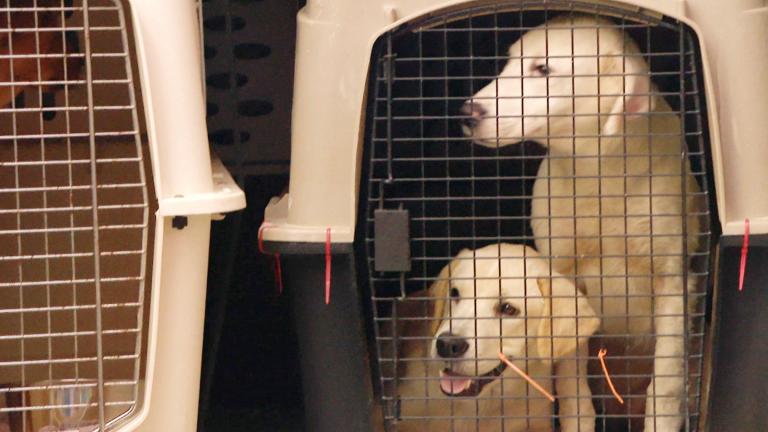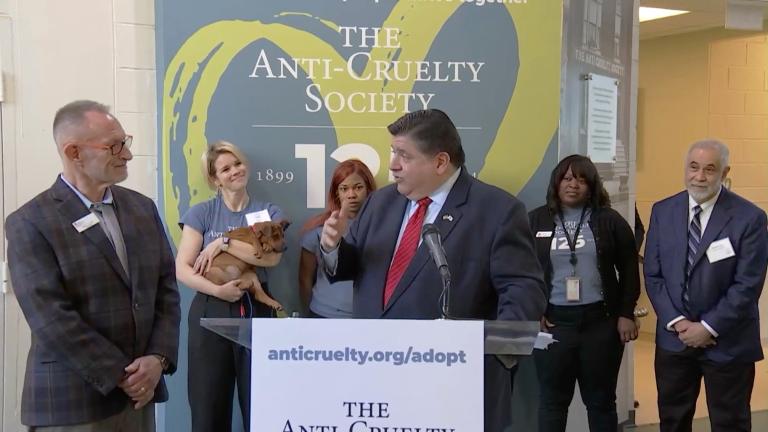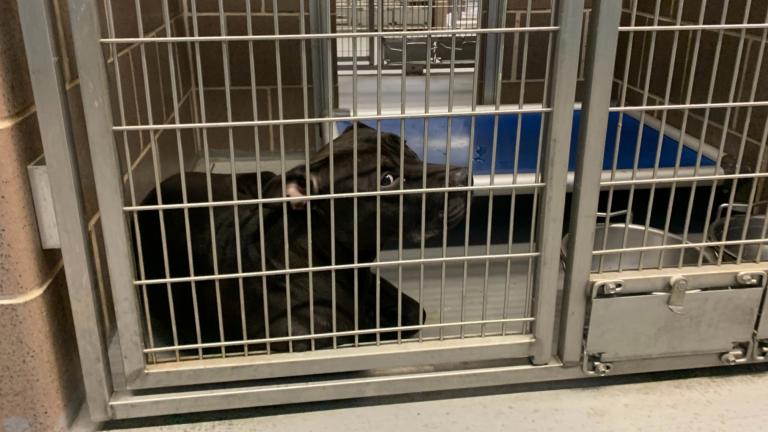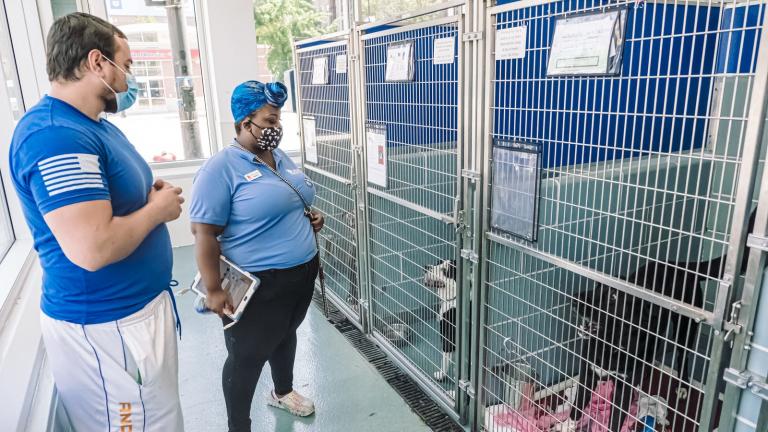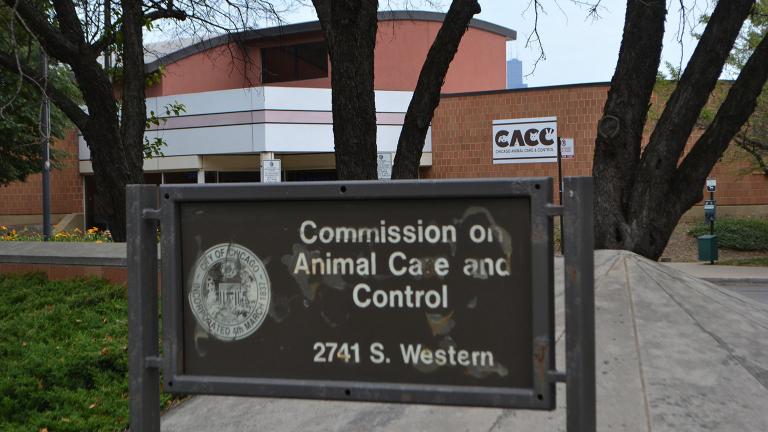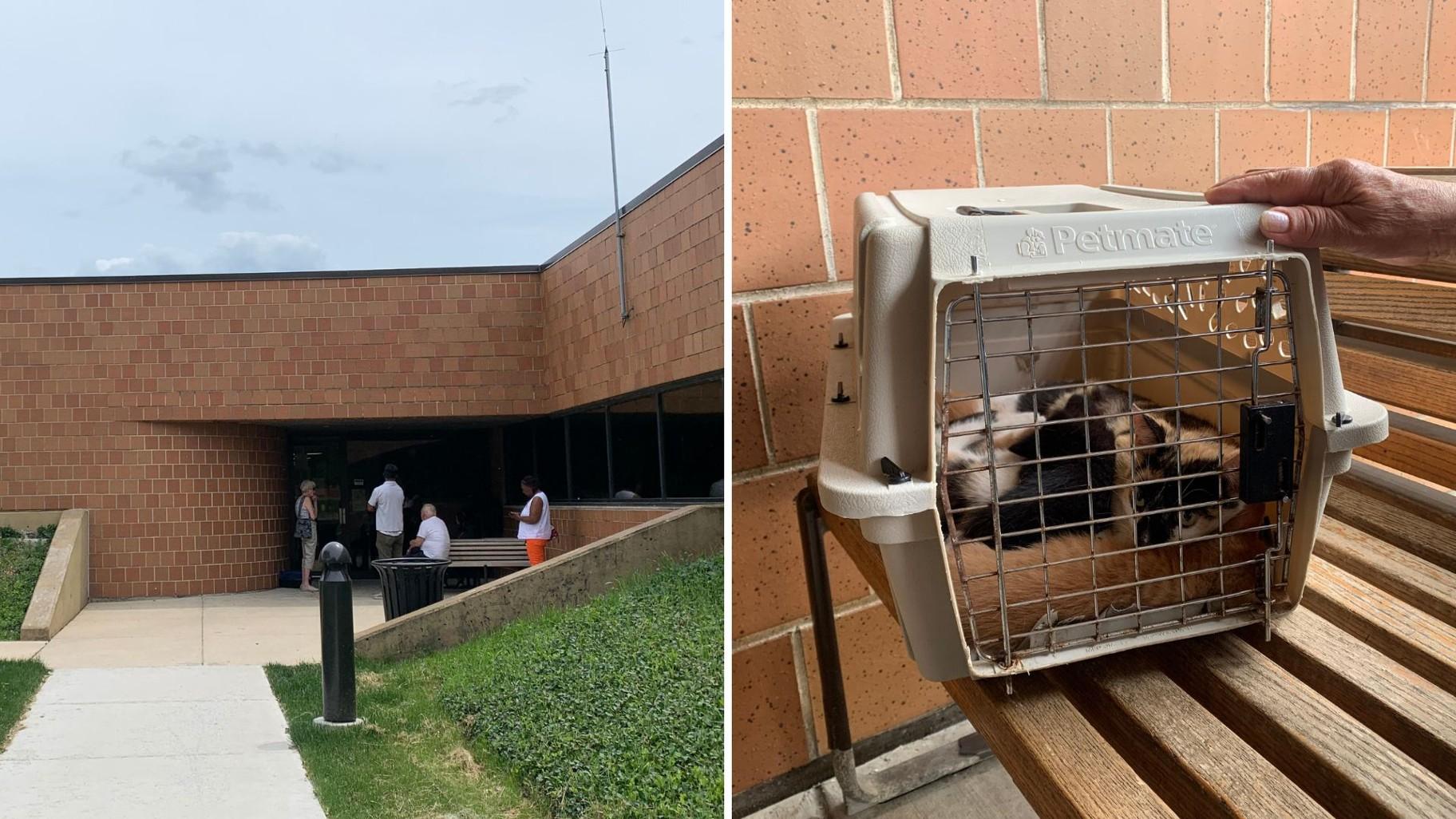 Left: Even before Chicago Animal Care and Control opens its facility to the public, people begin forming a queue outside its intake doors on the Lower West Side on May 20, 2024. Right: A cage containing a litter of kittens that a resident waits to drop off at the shelter. (Eunice Alpasan / WTTW News)
Left: Even before Chicago Animal Care and Control opens its facility to the public, people begin forming a queue outside its intake doors on the Lower West Side on May 20, 2024. Right: A cage containing a litter of kittens that a resident waits to drop off at the shelter. (Eunice Alpasan / WTTW News)
In the early morning hours, workers at Chicago Animal Care and Control walk the perimeter of its facility on the Lower West Side looking for any dogs and cats that might be tied up outside.
Finding animals tied to the fence or front door is a trend the shelter has seen more often lately, according to Chicago Animal Care and Control public information officer Armando Tejeda. Some people even cut open the fence to leave dogs in the shelter’s yard.
These are just fragments of a larger landscape of issues that shape the reality of what shelters in the city, and across the country, have been facing in the years since the COVID-19 pandemic. With summer considered one of the busiest times of the year for strays and euthanasia at the city shelter, the shelter and its rescue partners are seeing no signs of relief any time soon.
“We’re getting slammed with animals right now,” Tejeda said.
On any given day, a handful of people — some with caged animals — will begin forming a queue outside the shelter’s intake door before the facility even opens to the public at noon.
An ongoing surge of stray animals coming into the shelter, and not enough adoptions to match, led the city to see a 16% increase in euthanasia, or 94 more animals euthanized, from January to April 2024 compared to the same time last year, according to city data.
The city shelter is currently on pace to surpass last year’s record-high euthanasia counts and stray animal intake, as the shelter continues to struggle with overcapacity. From January to April of this year alone, 669 animals were euthanized, city data shows.
With an expected busy summer ahead, leaders at the city shelter and its rescue partners are urging residents to consider adopting or fostering a pet, especially large dogs, who have been the hardest to find homes for.
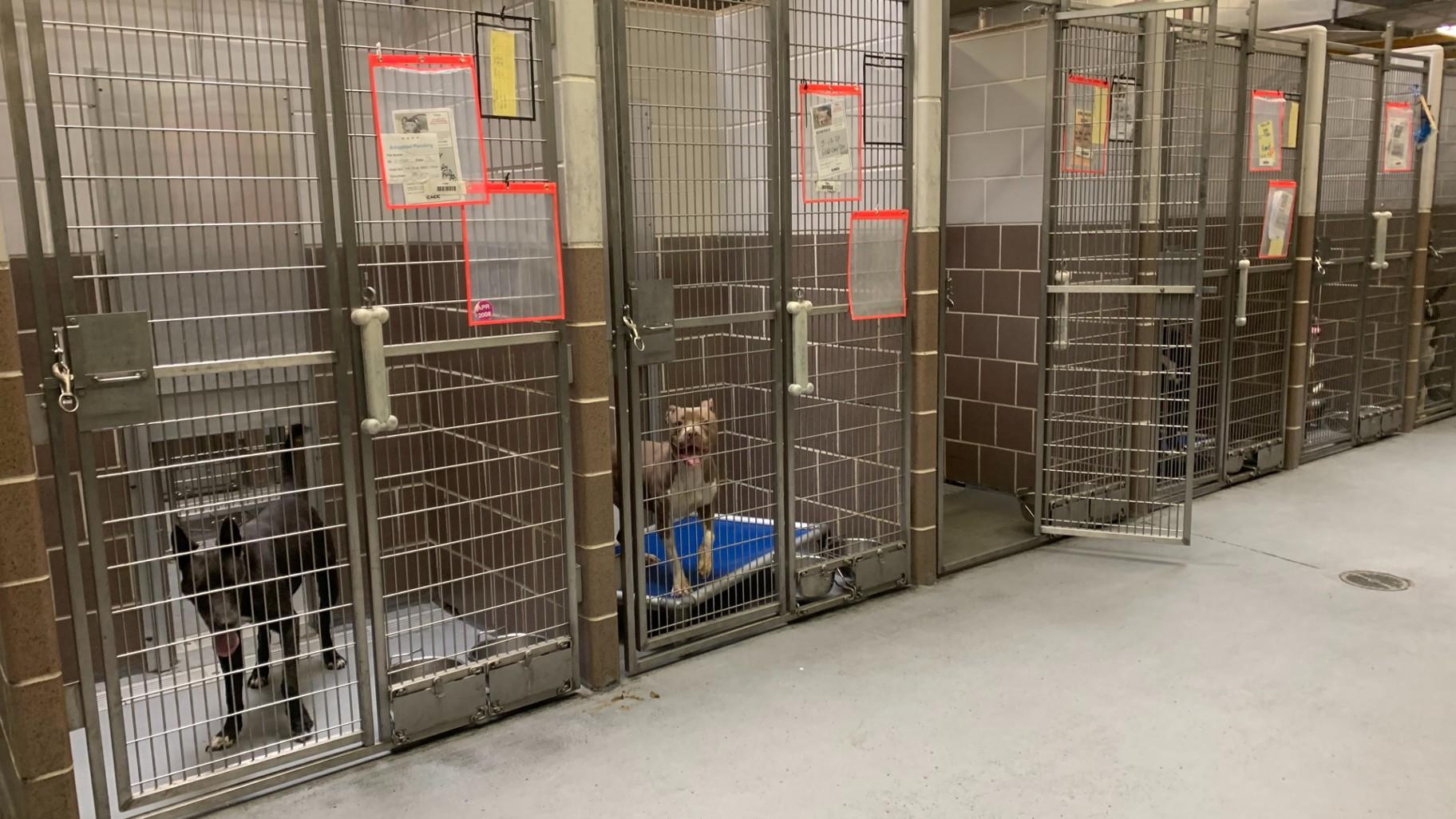 Dogs at Chicago Animal Care and Control on the Lower West Side on May 20, 2024. (Eunice Alpasan / WTTW News)
Dogs at Chicago Animal Care and Control on the Lower West Side on May 20, 2024. (Eunice Alpasan / WTTW News)
As workers in the animal welfare space desperately try to find placements for animals, they acknowledge barriers that have also made it increasingly difficult for people to adopt, foster or even keep their current animals.
Barriers include not being able to afford the cost of caring for a pet due to inflation, and certain housing policies such as no-pet restrictions and other restrictions based on animal type, breed, size and weight.
WTTW News reported last year euthanasia was up 25% at the city animal shelter through October. By the end of 2023, the shelter saw a high of more than 2,100 animals euthanized, surpassing pre-pandemic numbers.
(Euthanasia data refers to animals under the care of Chicago Animal Care and Control that are euthanized for reasons related to health, behavior and/or the shelter’s capacity for care. It does not include euthanasia performed by request of an owner.)
Of the animals euthanized so far this year at the shelter, the majority — 69% — are dogs. Cats accounted for 17% of animals euthanized.
PAWS Chicago CEO Susanna Wickham, whose organization’s mission is to end euthanasia of homeless dogs and cats at the city shelter, said the issues that came to the forefront since the pandemic, such as fewer adoptions and veterinarians, could take years to play out.
Even though the city shelter saw a low in stray animals in 2020, the current overcrowding can be traced back, in part, to the pandemic lockdown when there was a rise in backyard breeding and more limited access to veterinary clinics for spay and neuter services, shelter leaders said.
“There are all these factors contributing to a crisis that we’re seeing nationally and also in Chicago of pets being relinquished, stray pets being born,” Wickham said. “When there’s a reversal of progress on spay/neuter — the whole point of that is to reduce exponential breeding — any period of time that is not available to people, you see that effect continue to grow over months and years.”
The number of stray animals entering the city shelter this year through April increased by about 450 — a 16% increase — compared to the same time last year, according to city data. The shelter saw just over 3,200 stray animals through April of this year compared to the nearly 2,750 strays it saw in the same time last year.
Warmer weather also means a rise in litters, which shelters tend to see more of in the summer season. Mild winters, like Chicago’s most recent winter, contributed to the stray intake numbers the city shelter has seen so far this year, according to Tejeda.
“When our winters are mild, we don’t really get a break,” Tejeda said. “It’s like nonstop kittens are being born, moms are out there having babies and we’re seeing more animals — they’re just venturing outside (and breeding) more when it’s warmer.”
 Left: Animal shelter volunteer Melissa Taylor plays with dog Mars at Chicago Animal Care and Control’s yard on the Lower West Side on May 20, 2024. Right: Previous fence repairs from people cutting open the shelter’s fence to leave dogs in the yard, according to Chicago Animal Care and Control Public Information Officer Armando Tejeda. (Eunice Alpasan / WTTW News)
Left: Animal shelter volunteer Melissa Taylor plays with dog Mars at Chicago Animal Care and Control’s yard on the Lower West Side on May 20, 2024. Right: Previous fence repairs from people cutting open the shelter’s fence to leave dogs in the yard, according to Chicago Animal Care and Control Public Information Officer Armando Tejeda. (Eunice Alpasan / WTTW News)
PAWS Chicago, a major rescue transfer partner for the city, has expanded its spay and neuter services to help deal with animal overpopulation. Another issue PAWS Chicago is hoping to tackle is the decrease in animals being transferred out of the city shelter by rescue partners who are without an in-house veterinary staff.
PAWS Chicago recently launched a program called “Rescue Ready.” It allows rescue partners to bring large-breed dogs or cats pulled from the city shelter to PAWS to receive a vet exam, spay or neuter surgery, a microchip and the vaccines needed to get the animal ready for adoption.
Rescue partners pay a flat rate of $65 per animal for the PAWS Chicago services, which would typically cost hundreds of dollars or more at a veterinarian’s office, according to the organization.
“If you’re at a shelter with limited resources … and you don’t have a vet on staff, many shelters found themselves unable to continue transferring from (Chicago) Animal Care and Control,” Wickham said. “We really want to help rescues all over the Chicagoland area transfer more pets.”
While adoptions at the city shelter have increased since the pandemic — and also typically go up in the summer months — they are severely outpaced by the volume of stray animals the shelter takes in.
In 2023, more than 2,300 animals were adopted out as the number of stray intakes reached almost 10,000 animals, city data shows.
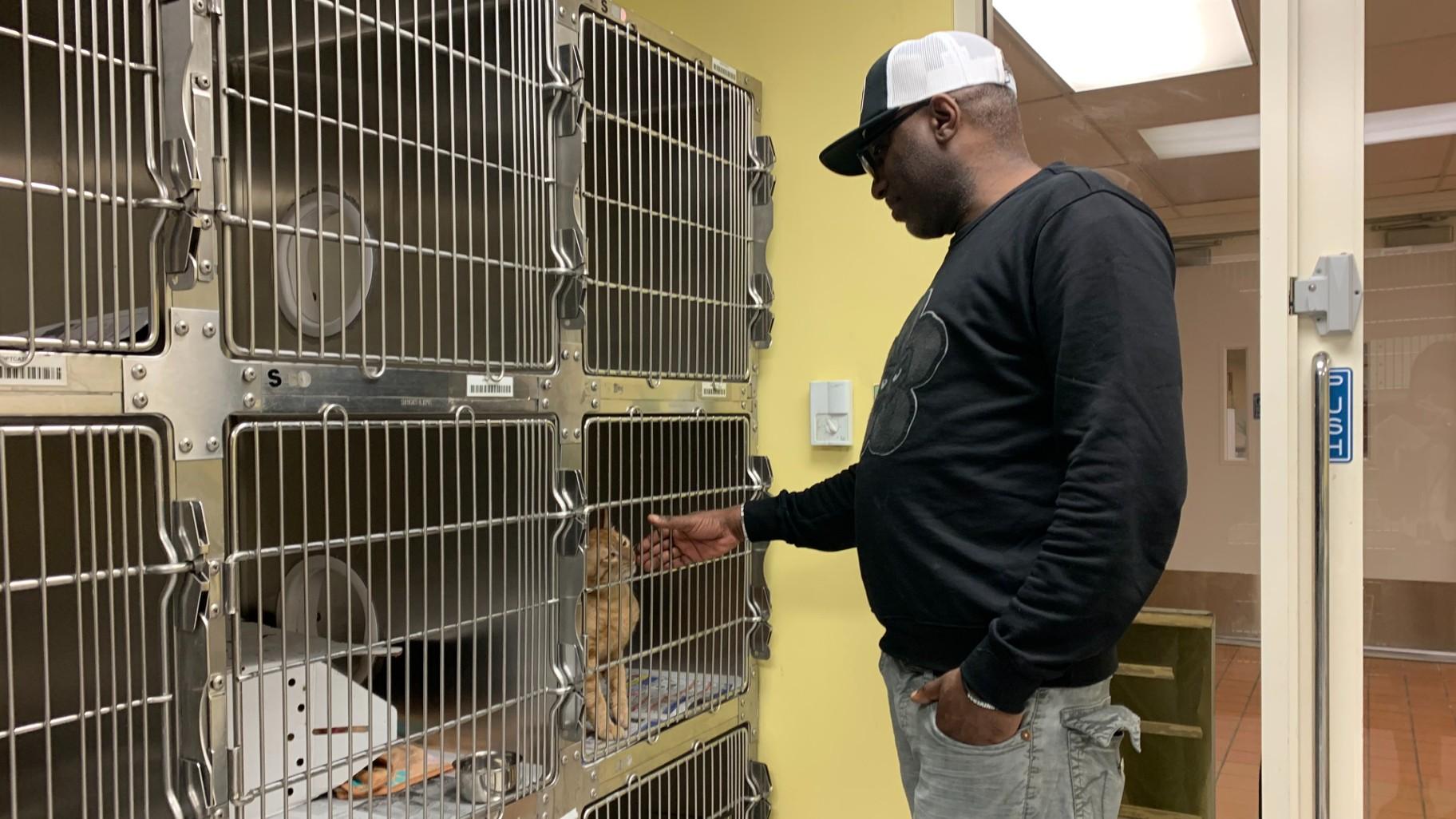 Potential adopter Earl Muhammad from Woodlawn plays with Pickles the cat at Chicago Animal Care and Control on the Lower West Side on May 20, 2024. (Eunice Alpasan / WTTW News)
Potential adopter Earl Muhammad from Woodlawn plays with Pickles the cat at Chicago Animal Care and Control on the Lower West Side on May 20, 2024. (Eunice Alpasan / WTTW News)
Several initiatives at the city shelter aim to increase adoptions.
Starting Tuesday, the shelter is making its Doggie Day Out program open to the public. The program is designed to help long-term shelter dogs experience life outside of the shelter and help promote their adoption or rescue.
The shelter is also waiving adoption fees on weekends through the end of the year, in addition to waiving adoption fees for animals who have been in the shelter for more than 60 days.
“When (adopters) take animals out, that helps the next animal coming in,” Chicago Animal Care and Control Executive Director Susan Cappello said.
Click here for information from PAWS Chicago about responsible pet ownership.
Contact Eunice Alpasan: @eunicealpasan | 773-509-5362 | [email protected]

